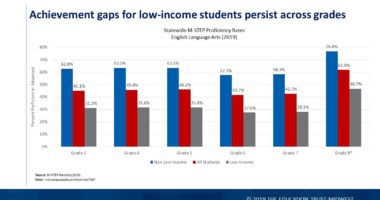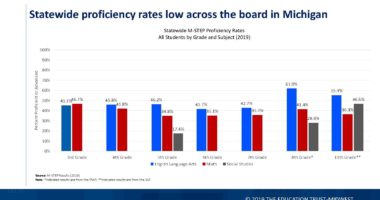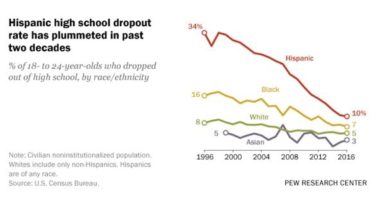Michigan needs a smart, statewide system to measure student growth
by Amber Arellano, Teresa Weatherall Neal, Audrey Spalding, Michael Rice, Ray Telman, Jon Felske and Harrison Blackmond
[An earlier version contained a summary of this column that was placed below the bylines, inadvertently making it appear as if that summary was written by the authors. The summary was in fact written by Bridge.]
As Michigan education leaders who work in very different sectors, we often see education reform from different points of view. It’s rare for all of our organizations to agree on complex policy changes, but there are times when a public problem and solution make so much common sense, it brings us together.
Michigan’s lack of reliable and accurate student growth data is one of these issues. Our state’s education data infrastructure is among the bottom third in the country, according to Education Week and many national observers.
One of the central problems: Michigan education data do not take into account the vast differences in students’ socioeconomic backgrounds. Widespread national research tells us that low-income children come to school with far greater deficits compared to their more affluent middle-class peers. Students living in poverty, on average, start their K-12 academic careers far behind their wealthier peers, even by the time they start first grade. For example, according to Grand Rapids Public Schools, 83 percent of students who begin kindergarten in the district are already one to two years behind in reading.
Yet our K-12 education data system doesn’t take into account these differences nor does it provide reliable student growth data for any district in the state. That needs to change.
In the coming months, there’s an opportunity to do just that. Presently policymakers are debating Michigan’s proposed statewide educator evaluation and support system. One very important tool in this system is a statewide student growth tool that will generate comparable – and far more reliable – student growth data, to be used as one of multiple measures in educator evaluations in Michigan.
If it’s done right, a new growth tool will use data from a new state assessment aligned to college- and career-ready standards, and provide more accurate data on student learning. Done right, this data system will be aligned with Pre-K data systems now being built, as well as a longitudinal K-16 data system that has been in development for a few years.
We support the state’s development and support of this tool. Today, Michigan parents and educators have no idea whether their schools’ teaching quality and classroom learning levels are better than other schools’, or if a district simply set a low bar for quality. That’s because there is now a patchwork of ways in which our state’s school districts and charter operators measure student learning — and each one is left to define what a year of student growth should be.
Ed Trust-Midwest’s research has found many local student growth models in our state actually underestimate teachers’ impact on student learning. That’s neither sound nor fair to educators and students. That’s why it’s important that the state provides high-caliber, reliable, comparable growth data for all districts to adopt — and use as at least one measure in their local evaluation systems.
As a state, we also need to make sure this new student growth model is reliable, thoughtful, technically sound and fair to educators and students, including those in high-poverty and working-class communities. In other words, it should be smart.
To reach that goal, the state’s growth model should account for previous student achievement and other variables, such as poverty — and provide a measure of individual teacher effectiveness, averaged over multiple years, for use in educator evaluations.
Why is this so important? Student growth measures that are not such so-called value-added models risk penalizing educators for teaching in high-poverty schools — and may vastly underestimate student growth in urban, rural and even many suburban communities. This makes it even more difficult for such schools to attract and retain effective teachers and school leaders.
We know how fundamentally important teachers are. Research shows the most important in-school predictor of a student’s achievement is teaching quality.
Indeed, we need to support our teachers not only with fair data and evaluations, but with smart data that actually helps them inform their instruction. Such smart growth tools — especially when generated based on a high-caliber assessment— can provide valuable diagnostic information about students.
This tool could be truly transformative for our schools. Educators in leading states not only receive such data on their students’ learning gains, but they also use individual student “projection reports” that signal whether a student is on track to graduate from high school and even how ready he or she is for college and career entrance exams — as early as elementary school.
Such data would allow Michigan educators to intervene earlier in students’ academic careers, tailor instruction and improve teaching strategies. Most states make student projection reports available to parents upon request, too.
Imagine what parents, teachers and school leaders could do, together, if they knew a fourth-grader is already off track to be college- and career-ready. The potential for helping our students is enormous.
Educators also can use such data to help low achievers who are progressing slowly by providing earlier, targeted intensive support. Educators also can provide more challenging instruction to high-achieving students who are insufficiently challenged in school.
Some might say, “Sounds nice, but wouldn’t such data set lower expectations for low-income or lower-achieving students?”
The answer: Michigan already has a rigorous, high-stakes school accountability system that expects Michigan students to be proficient at the same high levels. And this measure also would be just one measure among multiple measures of performance in any comprehensive educator evaluation and support system.
If properly designed, Michigan’s new student growth data would provide a vastly more accurate way to measure student performance — and ensure that school professional development, staffing decisions and student placements and interventions are made much more thoughtfully, strategically and smartly.
We need a Michigan smart student growth model. In the coming months, we need to take that opportunity.



